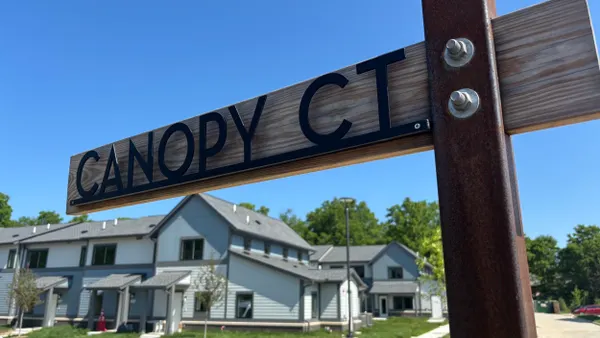Dive Brief:
- Less restrictive zoning policies were associated with a less than 1% increase in housing supply within three to nine years after such reforms passed, according to a study the Urban Institute published Wednesday. The researchers found no statistically significant evidence that such reforms increased the availability of affordable housing in that period, however.
- Reforms that decrease zoning restrictions were associated with a $61 decrease in median gross rent while more restrictive zoning reforms were associated with a $50 increase in median gross rent, the study found.
- The findings suggest that loosening zoning restrictions can boost the new housing supply, especially for market-rate housing. “But this increase is likely inadequate to increase the availability of housing affordable to low- and middle-income households in the short-term,” the study says. “Cities should consider pairing direct investments in housing subsidies” with looser zoning policies to address short-term and long-term housing affordability, it says.
Dive Insight:
The U.S. is in the midst of a national housing shortage, with single-family housing starts trailing household formation by 6.5 million homes between 2012 and 2022. According to the National Low Income Housing Coalition, the country is also short 7.3 million rental homes that are affordable and available to renters with extremely low incomes. “Only 33 affordable and available rental homes exist for every 100 extremely low-income renter households,” according to an NLIHC analysis.
Among other initiatives, lawmakers at the local, state and federal levels are trying to increase the availability of affordable housing by providing developers with financial incentives to build more housing and housing subsidies to people struggling with affordability. States and cities are also relaxing zoning restrictions to allow accessory dwelling units and multifamily housing in areas formerly zoned for single-family housing in addition to other zoning changes.
While the report found that more permissive zoning was associated with a slight increase in housing supply, the upper half of the rental market accrued most of the gains. The increase in rental units affordable to families with incomes above the national median could be 15% to 70% in the short term and 15% to 112% after three years, the researchers estimated. “After such reform passage, we find an increase in units affordable to families with incomes above the national median of 43% in the short run and 63% in the medium to long run,” the study says.
Less restrictive zoning had a positive, but not statistically significant, effect on the supply of rental units affordable to households with very low or extremely low incomes, defined as households earning 30% to 50% or up to 30% of the median income, respectively. The study’s authors said they did not have enough information to establish statistical significance because there were too few affordable housing units in the baseline data. “Even so, at the metropolitan scale and in the longer run, we expect that more construction reduces costs,” the study says.
Yonah Freemark, study co-author and senior research associate at the Urban Institute, said in an email that the findings “clearly demonstrate" that zoning changes that reduce housing density, called downzoning, "have negative impacts on housing affordability. These policies restrict housing construction and make it more difficult for people to be able to live in communities near jobs and good-quality schools. Local leaders should be very hesitant to downzone neighborhoods for this reason.”
Measures that specifically address affordable housing, such as direct investments in housing vouchers and project-based subsidies for publicly assisted housing, may help address housing affordability better, the researchers say.
Growth in market-rate housing might cancel out the affordability gains of increased supply because new units are more expensive and offer nicer amenities, which could make an entire housing market more attractive to renters, the researchers theorize. “In other words, certain zoning reforms may induce more construction, but rather than opening up existing units in the surrounding area for lower-income families, existing housing units maintain relatively stable rents due to increased demand,” the study says.
To carry out the study, researchers at the Urban Institute and the University of Illinois at Urbana-Champaign used artificial intelligence to create the first cross-city panel data set of land use reforms that increase or decrease housing density and estimated their association with changes in housing supplies and rents.
Using this method, the researchers identified 180 major land use reforms in the study period of 2005 to 2019, including 84 that increased restrictions and 96 that loosened them, in 1,136 cities. Most of the reforms were related to accessory dwelling units and minimum lot sizes, but the researchers also looked at other changes, such as height limits and floor-area-ratio requirements.
Lydia Lo, study co-author and research associate at the Urban Institute, said in an email that it was difficult to find data on zoning changes. "States and regional governments should have access to these data on what zoning laws and reforms their member jurisdictions are making, and they should be able to consider those actions and laws in light of development and economic growth pressures to ensure that no area is exempt from the responsibility to provide subsidized, dense housing in the face of development pressures.”
This story was updated with comments from two of the study's co-authors.











